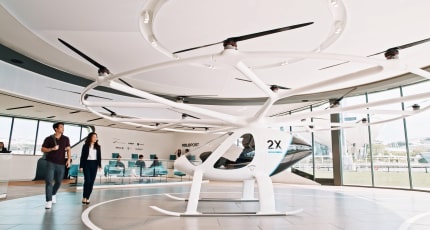Battling COVID 19 where Airplanes, buses and trains have seen lower number of transits, there’s one startup – flying taxi: Volocopter, that has managed to raise some significant amount of funding. Flying taxi is hoping to pioneer a totally new approach to get individuals from A to B.

Volocopter and its plans
Founded in 2011, A startup of southern Germany, Volocopter, that has been building and testing electric VTOL (vertical take-off and landing) aircraft, has picked up €200 million (about $241 million) in a Series D round of funding. Alongside its aircraft, Volocopter has also been building a business case in which its vessels will be used in a taxi-style fleet in urban areas. CEO Florian Reuter tells us that live services are now two years out for the two-vehicle models it has been developing.
We are actually expecting to certify our VoloCity in around two years and start commercial air taxi operations right after,”. “Paris and Singapore are in pole position [as the first cities], where Paris wants to have electric air taxis established for the 2024 Olympics. With our VoloDrone, we expect first commercial flights even earlier than with our VoloCity.
CEO
Volocopter, till now, has already proven itself in flights in Helsinki, Stuttgart, Dubai, and over Singapore’s Marina Bay. In addition to Europe and Asia, it also wants to launch services in the U.S.
The idea behind flying taxi
Considering its very wide circular design that sits where the rotor on a helicopter would be, the idea is very distinctive. Volocopter has been working on this idea for a whole decade, and in many regards, it’s the classic idea of a moonshot in action.
Though it has yet to make any money, the product that it’s building to do so is very groundbreaking and ultimately untested.

Things that might play in favor of Volocopter
Volocopter is not the only one working on “flying taxi” concepts. There are other very well-capitalized companies like Lilium, Joby Aviation, Kitty Hawk, and eHang.
However, all of these have faced various hurdles. From investor lawsuits to bankruptcies, accidents mothballed projects, and divestments. Most importantly, none of them are flying commercially yet. With Volocopter, investors have taken a long-term bet here on a concept and a team it believes can deliver.
Adaptation is the key
In wake of the pandemic, everybody is more focused on considering new approaches to old problems to improve efficiency. Facing all the new challenges, The company has said that for now, technology is not a barrier, and nor are the regulators, who have acknowledged that they might have to do things a little differently from now on, in the wake of new demands from public health.
In the case of VTOL craft, the promise has always been that they could bypass a lot of the issues with street congestion in urban areas, and provide a more environmentally safe alternative compared to the present-day transportation modes.
However, the main challenge is determining the safety of both completely new devices and of the traffic and other systems that they would operate under. The idea that these crafts would ultimately be autonomous, adds another complex twist.
Challenging times ease the way for new perspective
Interestingly, regulators in different markets that might have been more skeptical of new concepts seem to be more open to considering them differently now with the pandemic at hand. The same has been seen in other areas, too, such as the electric scooter market in the U.K., which saw a bump in activity after regulators’ long skepticism gave them a provisional nod last year, citing the need for more individualized transportation options in a pandemic-hit country.
Volocopter’s model is based around transporting one person or small parties, so in a sense might be attractive here too.
There aren’t any major hurdles anymore in terms of the technology as such. It is now all about execution. EASA has defined what is necessary to get electric air taxis certified to the highest safety level in aviation. We have the best technology in the market to certify to EASA’s high safety standards and will keep our heads down to finalize the few remaining steps to certification.
Reuter
In contrast, he said the other challenges that remain are those of any highly technical startup: “Our largest challenge right now is talent acquisition,” he said. “We are looking for the best talents worldwide and growing our team quickly now so that we can accelerate on the technical and market development sides. Especially in the markets where we will open early routes, such as Paris, Singapore, China, and Japan, we are going full speed in preparing everything necessary from digital infrastructure to landing sites, city approvals, and more.”